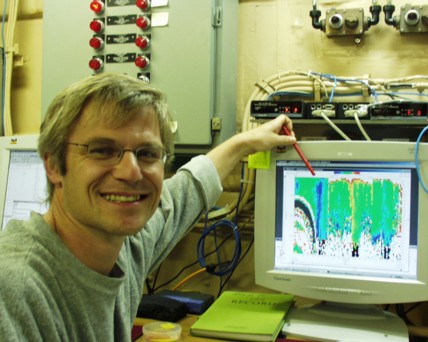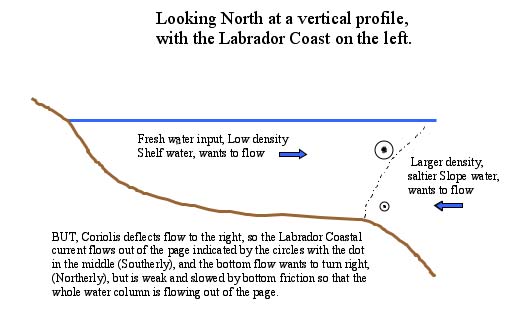|
|
Expedition
Expedition | People
|
Log - July-24-2003
by Robert McCarthy
Previous | Next
| Labrador Current |
| Today we passed into the Arctic Circle (Latitude 66 degrees, 40 minutes North), and we continue to have excellent weather. Seas have remained less than 5 feet. Now that we are north of the southern tip of Greenland, we are not too far away from land. Hence the fetch, the distance the wind can blow on the sea surface to generate waves, is fairly small. Think about blowing across the top of your mug to cool your coffee. Those little waves that are created are termed capillary waves, because the restoring force (the force that wants to return it to a flat surface) is surface tension. Sustained blowing will create larger waves termed gravity waves, because gravity becomes the restoring force. To generate very large waves you need high winds, a long time for them to interact with the waves, and a long fetch. So the waves we will experience now will be fetch-limited.
|
 |
 |
We passed through the Labrador coastal current as we steamed from St. JohnÕs, Newfoundland to our present location. The signature appeared on the data from the underway Acoustic Doppler Current Profiler (ADCP) which is mounted on the shipÕs hull. This instrument sends down an acoustic (sound) signal and measures the horizontal velocity of the water as a function of depth. The Doppler shifted return signal determines the velocity of the water (similar to how police use radar to determine the speed of a car). Also, you are familiar with the observed change in pitch when a train passes you; high frequency approaching, and a lower frequency leaving. Dr. Andreas Muenchow said the current was barotropic, which means that the flow did not reverse with depth. The strength decreases with depth (due to friction), but the whole water column was flowing in a Southerly direction at a velocity of about 1 knot. This flow is driven by a simple balance between pressure gradient of the sea surface slope and the Coriolis force which deflects motion to the right in the northern hemisphere. The sea surface is higher along the Labrador Coast, because fresh water is lighter than salt water, and there is a large influx of freshwater from streams, snow melt, and ice melt. This water would like to flow downhill, (i.e. straight off shore) but the Coriolis force deflects this water to the right, thus forming the Labrador Coastal Current. My diagram doesnÕt show this surface slope, but it is implied with the lighter shelf water meeting the saltier slope water. Being a former physical oceanographer, I am excited to be looking at these types of measurements again, and Dr. Muenchow is anxiously awaiting arriving at the designated stations. |
|
|
